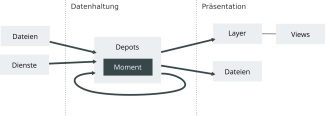Introduction
In the following, the PlexMap data model and its terminology are presented. Basically, PlexMap distinguishes between the data storage layer (database) and the presentation layer (layers & views).
The central element of the data storage layer in PlexMap are the depots. Depots are most comparable to a file in a file system. Thus, they consist of data, each of which can be assigned to a specific data type (e.g. Grid or Feature). If desired, depots can be sorted into individual folders.
To enable a complete update of data sets, depots are always versioned. This means that for each data or service import into a depot, a so-called moment is always automatically created. A moment is to be understood as a time or processing status of the imported data. Moments can be accepted and deleted by PlexMap administrators. If they are accepted, a moment becomes the master and thus represents the status of the data or services managed in the depot, which is valid for all other users.
The presentation layer consists of layers and views. Layers are derived from depots and consist of the web optimized data with a style definition. Views are map representations that consists of one or more layers. Views can be presented online to the end users by appropriate approvals in the view editor.
